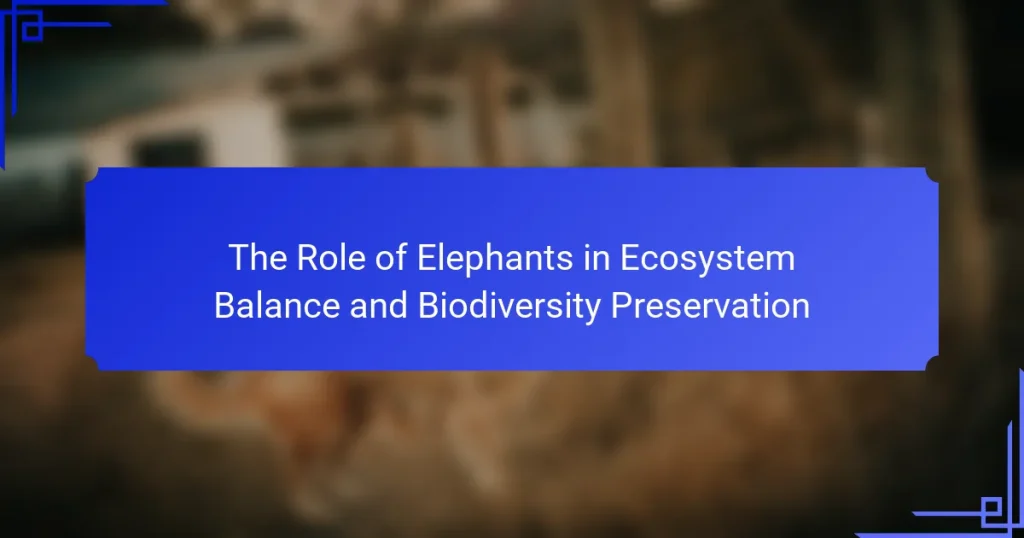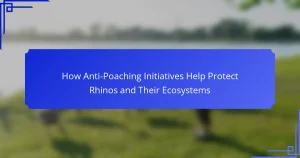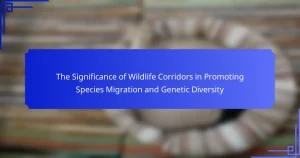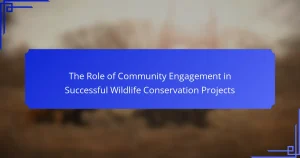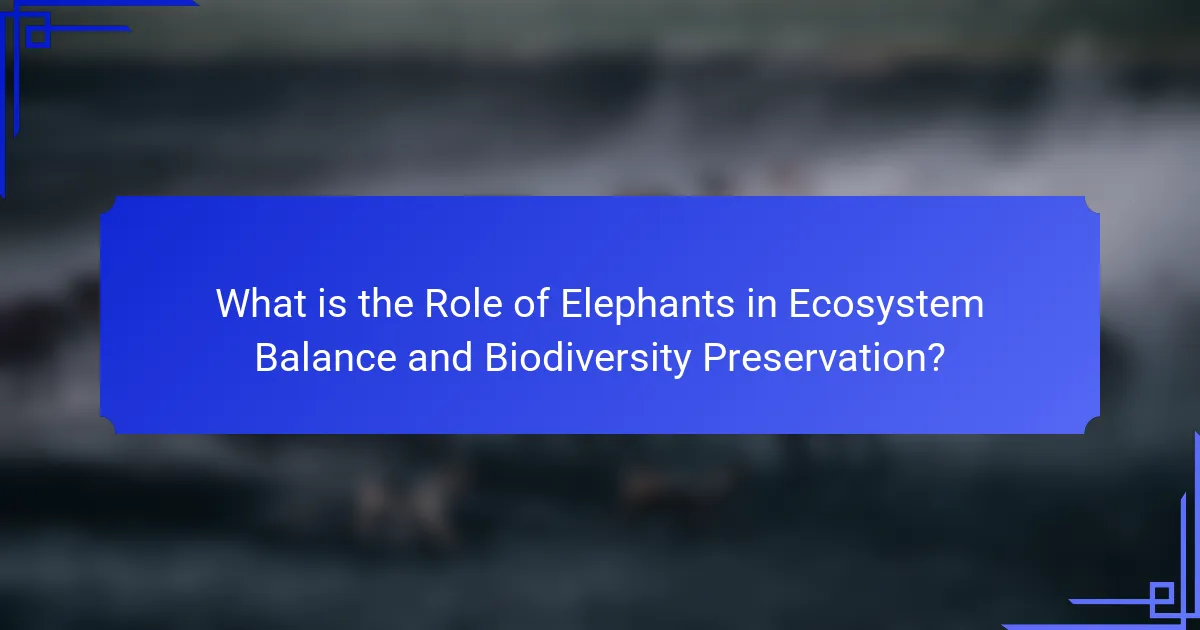
What is the Role of Elephants in Ecosystem Balance and Biodiversity Preservation?
Elephants play a crucial role in ecosystem balance and biodiversity preservation. They act as ecosystem engineers by modifying their habitats. Elephants create water holes that benefit various species during dry seasons. Their feeding habits help control vegetation growth, which maintains the health of grasslands and forests. By uprooting trees, elephants promote the growth of new plants and increase habitat diversity. Their dung serves as a nutrient-rich fertilizer, supporting soil health and promoting plant growth. Studies show that areas with elephants have higher biodiversity compared to those without. This highlights their importance in sustaining ecological balance.
How do elephants contribute to ecosystem balance?
Elephants contribute to ecosystem balance by acting as keystone species. They shape their environment through feeding and movement. Elephants consume large amounts of vegetation, which helps maintain the structure of grasslands and forests. Their foraging creates pathways that allow other species to thrive. Elephants also disperse seeds through their dung, promoting plant diversity. This seed dispersal is crucial for the regeneration of various plant species. Additionally, their waterholes provide hydration for numerous animals during dry periods. Research shows that areas with elephants have higher biodiversity levels. Their presence supports a wide range of flora and fauna, demonstrating their critical role in ecosystem health.
What specific behaviors of elephants impact their environment?
Elephants significantly impact their environment through behaviors such as foraging, digging, and trampling. Foraging behaviors lead to the consumption of vast amounts of vegetation. This process helps maintain the structure of ecosystems by preventing any one species from dominating. Digging for water and minerals creates water holes that benefit other wildlife. Trampling pathways and clearing vegetation aids in seed dispersal and promotes new plant growth. Elephants also create habitats for other species by uprooting trees, which fosters biodiversity. Their social structures and migratory patterns further enhance landscape diversity. Research indicates that elephants are considered ecosystem engineers due to these impactful behaviors.
How do elephants influence the plant and animal communities around them?
Elephants significantly influence the plant and animal communities around them. They act as ecosystem engineers by modifying their habitats. Elephants uproot trees and shrubs, creating open spaces. This promotes grass growth and increases biodiversity. Their foraging habits help disperse seeds across large areas. This seed dispersal enhances plant diversity and contributes to forest regeneration. Additionally, elephant dung provides nutrients for soil and supports various organisms. Studies show that areas with elephants have higher species richness. Their presence fosters a balanced ecosystem, benefiting numerous plant and animal species.
Why are elephants considered keystone species?
Elephants are considered keystone species because they significantly shape their ecosystems. Their feeding habits create clearings in forests, allowing sunlight to reach the ground. This promotes the growth of various plant species. Elephants also help disperse seeds through their dung. This aids in plant regeneration and diversity. Additionally, their movement through habitats creates pathways for other animals. Research shows that areas with elephants have higher biodiversity. Their presence influences the population dynamics of other species. Thus, elephants play a crucial role in maintaining ecological balance.
What defines a keystone species in an ecosystem?
A keystone species is an organism that plays a critical role in maintaining the structure of an ecosystem. Its presence or absence significantly impacts the ecosystem’s biodiversity. Keystone species help regulate populations of other species, preventing any one group from dominating. For example, sea otters control sea urchin populations, which in turn affects kelp forests. The removal of a keystone species can lead to drastic changes in the ecosystem. This concept was first introduced by Robert Paine in 1969, demonstrating that certain species have a disproportionately large effect on their environment. Elephants are often considered keystone species due to their role in shaping landscapes and influencing the populations of other species.
How do elephants fulfill this role in their habitats?
Elephants fulfill their role in habitats by acting as keystone species. They shape their environment through feeding habits. Elephants uproot trees and create clearings, which promotes grassland growth. This process benefits many other species by enhancing biodiversity. Their dung serves as a nutrient-rich fertilizer, supporting plant growth. Additionally, elephants transport seeds over long distances, facilitating plant dispersal. This behavior contributes to forest regeneration and ecosystem health. Studies show that areas with elephants have higher levels of plant diversity compared to areas without them. Overall, elephants maintain ecological balance and promote biodiversity in their habitats.
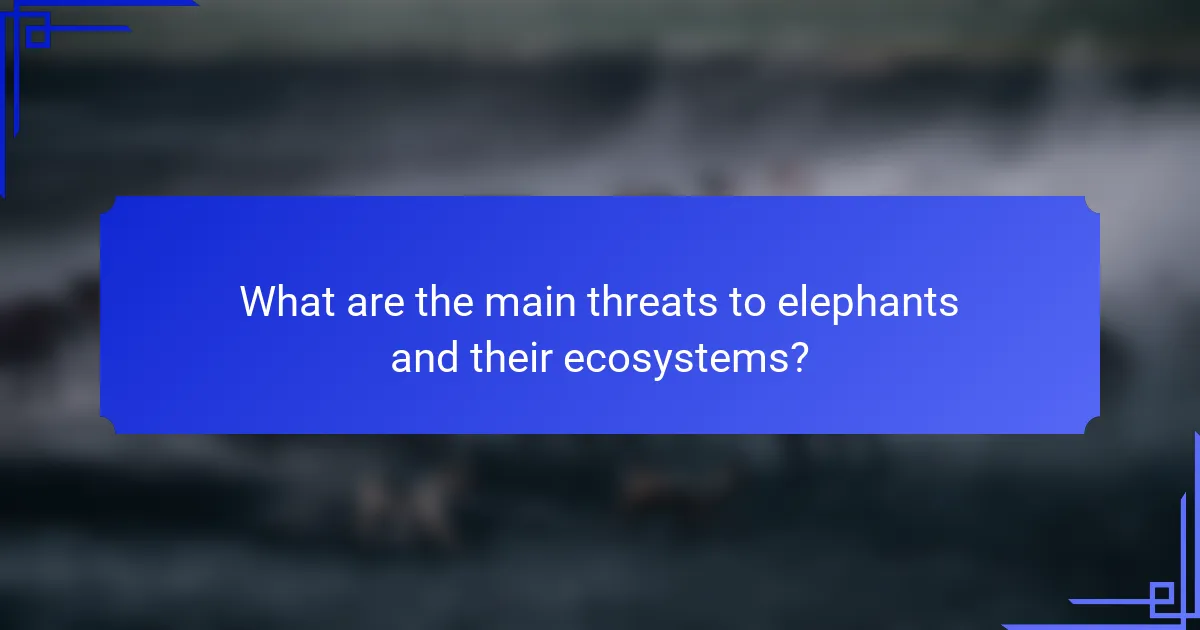
What are the main threats to elephants and their ecosystems?
The main threats to elephants and their ecosystems are poaching, habitat loss, and human-wildlife conflict. Poaching primarily targets elephants for their ivory, which has led to significant population declines. According to the World Wildlife Fund, between 2010 and 2012, an estimated 100,000 elephants were killed for their tusks. Habitat loss occurs due to agricultural expansion, urbanization, and deforestation, which reduces the space elephants need to thrive. The African Elephant Status Report 2020 indicates that elephant habitats have shrunk by 50% over the last century. Human-wildlife conflict arises when elephants encroach on human settlements, often leading to retaliatory killings. This conflict is exacerbated by habitat fragmentation, which forces elephants into closer proximity with people. These threats collectively undermine the ecological roles elephants play, such as seed dispersal and landscape management.
How does poaching affect elephant populations?
Poaching significantly reduces elephant populations. It leads to a decline in their numbers due to illegal hunting for ivory and other body parts. According to the World Wildlife Fund, elephants have faced a 62% decline in population over the last decade due to poaching. This loss disrupts social structures within herds and affects breeding. Fewer elephants mean less seed dispersal, impacting plant diversity. The decline also affects ecosystem balance, as elephants play a crucial role in maintaining habitats. Overall, poaching threatens both the survival of elephants and the health of their ecosystems.
What are the consequences of decreased elephant numbers on ecosystems?
Decreased elephant numbers lead to significant ecological consequences. Elephants are keystone species, meaning their presence is crucial for maintaining ecosystem balance. Their foraging behavior creates clearings in forests, promoting biodiversity by allowing sunlight to reach the ground. This process helps various plant species to thrive, which in turn supports numerous animal species.
Moreover, elephants facilitate seed dispersal. They consume fruits and excrete seeds across large areas, contributing to plant population growth. A decline in elephants reduces this vital service, potentially leading to decreased plant diversity.
Additionally, fewer elephants can result in habitat degradation. Their absence may allow invasive plant species to dominate, disrupting local ecosystems. This shift can negatively impact other wildlife that relies on native plants for food and shelter.
Overall, the decline in elephant populations disrupts the intricate web of life within ecosystems, leading to reduced biodiversity and altered habitats.
What measures are being taken to combat poaching?
Anti-poaching measures include increased law enforcement and community engagement. Governments and organizations are deploying more rangers to patrol protected areas. Technology such as drones and camera traps is being utilized to monitor wildlife. Legal frameworks are being strengthened to impose harsher penalties on poachers. Conservation programs are educating local communities about the importance of wildlife. International cooperation is enhancing efforts to combat wildlife trafficking. According to the World Wildlife Fund, these strategies have led to a decrease in poaching incidents in certain regions.
What impact does habitat loss have on elephants?
Habitat loss significantly impacts elephants by reducing their living space and food sources. Elephants require vast territories for foraging and migration. When their habitats are destroyed, they face food scarcity. This leads to increased competition for resources among elephants. Consequently, the stress from habitat loss can result in lower reproductive rates. Furthermore, fragmented habitats increase human-elephant conflicts. These conflicts often lead to negative outcomes for both elephants and humans. Studies indicate that habitat loss is a primary threat to elephant populations globally.
How does deforestation affect elephant migration patterns?
Deforestation disrupts elephant migration patterns by fragmenting their habitats. Elephants rely on vast, connected landscapes for seasonal movements. When forests are cleared, these pathways become blocked or altered. This can lead to increased human-elephant conflicts as elephants search for food and water. Additionally, fragmented habitats can isolate elephant populations. This isolation reduces genetic diversity and increases vulnerability to extinction. Studies show that elephants travel longer distances to find suitable habitats due to deforestation. This change in movement can also affect their breeding and social structures. Therefore, deforestation significantly alters the natural migration behaviors of elephants.
What are the implications of habitat fragmentation for biodiversity?
Habitat fragmentation negatively impacts biodiversity by isolating species and reducing genetic diversity. Fragmented habitats create barriers that limit animal and plant movement. This isolation can lead to inbreeding, reducing resilience to diseases. Smaller populations are more vulnerable to extinction. Habitat loss also decreases available resources such as food and shelter. The overall result is a decline in species richness and ecosystem health. Studies indicate that fragmented landscapes can lead to a 70% reduction in species diversity. This emphasizes the critical need for habitat connectivity to support biodiversity.
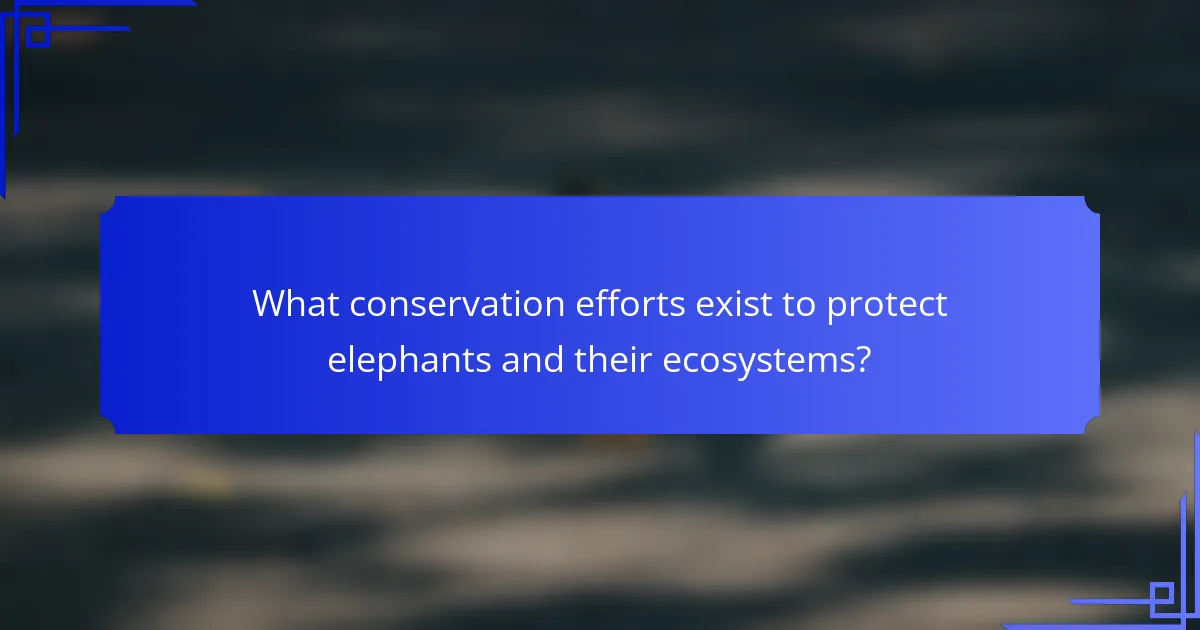
What conservation efforts exist to protect elephants and their ecosystems?
Conservation efforts to protect elephants and their ecosystems include anti-poaching initiatives, habitat preservation, and community education programs. Anti-poaching initiatives involve increased patrols and surveillance in protected areas. These efforts aim to reduce illegal hunting, which threatens elephant populations. Habitat preservation focuses on maintaining and restoring natural habitats. This ensures elephants have access to food and water sources. Community education programs raise awareness about the importance of elephants in ecosystems. These programs encourage local communities to engage in conservation efforts. Additionally, organizations like the World Wildlife Fund and African Wildlife Foundation actively support these initiatives. They provide funding and resources for effective conservation strategies.
How do protected areas benefit elephant populations?
Protected areas benefit elephant populations by providing safe habitats for their survival. These designated regions reduce human-elephant conflict by limiting human encroachment. Elephants thrive in protected areas where they can roam freely and access food and water sources. These areas also facilitate natural behaviors such as migration and breeding. According to the World Wildlife Fund, protected areas help maintain genetic diversity in elephant populations. This genetic diversity is crucial for their adaptability to changing environments. Moreover, protected areas contribute to ecosystem health, which in turn supports the species that rely on elephants. Healthy ecosystems ensure that elephants can fulfill their role as ecosystem engineers, further benefiting biodiversity.
What role do national parks play in elephant conservation?
National parks play a crucial role in elephant conservation by providing protected habitats. These areas offer safe environments free from poaching and habitat destruction. National parks maintain ecosystems that support the diverse flora and fauna elephants rely on. For instance, parks like Amboseli in Kenya support large elephant populations. Protected areas also facilitate migration patterns essential for elephants’ survival. Research indicates that elephants in national parks have a higher survival rate compared to those outside. Furthermore, national parks promote biodiversity, which is vital for ecological balance. By preserving elephants, national parks contribute to the overall health of ecosystems.
How can community-based conservation initiatives support elephants?
Community-based conservation initiatives support elephants by involving local communities in their protection. These initiatives empower residents to engage in sustainable practices. They provide education on the ecological importance of elephants. Additionally, they often create economic incentives for conservation, such as eco-tourism. Research shows that community involvement leads to better wildlife management outcomes. For instance, in Kenya, community conservancies have significantly reduced poaching rates. This model fosters coexistence between humans and elephants. Ultimately, these initiatives enhance both elephant populations and local livelihoods.
What can individuals do to help preserve elephants and their habitats?
Individuals can help preserve elephants and their habitats by supporting wildlife conservation organizations. These organizations work to protect elephant populations and their environments. Donations to such groups fund anti-poaching efforts and habitat restoration projects. Individuals can also participate in eco-tourism, which promotes conservation through responsible travel. Educating others about the importance of elephants in ecosystems raises awareness. Reducing plastic use helps minimize habitat degradation. Supporting legislation that protects wildlife further contributes to their preservation. By making conscious consumer choices, individuals can reduce demand for products that harm elephant habitats.
What are some effective actions individuals can take to contribute?
Individuals can contribute to the preservation of elephants and their ecosystems through various effective actions. Supporting wildlife conservation organizations helps fund anti-poaching efforts and habitat protection. Participating in local clean-up initiatives reduces pollution in elephant habitats. Educating others about the importance of elephants raises awareness and promotes conservation efforts. Choosing sustainable products minimizes habitat destruction caused by deforestation. Advocating for policies that protect wildlife can influence governmental action. Visiting ethical wildlife sanctuaries supports rehabilitation efforts for elephants. Donating to research projects enhances understanding of elephant behavior and ecology. Each of these actions plays a vital role in ensuring elephants thrive in their natural habitats.
How can awareness and education impact elephant conservation efforts?
Awareness and education significantly enhance elephant conservation efforts. Increased public knowledge fosters empathy and understanding towards elephants. Educational programs can inform communities about the ecological importance of elephants. This knowledge can lead to community involvement in conservation initiatives. For instance, educated individuals are more likely to support anti-poaching laws. Awareness campaigns can reduce human-elephant conflict by promoting coexistence strategies. Research indicates that regions with strong educational outreach see improved conservation outcomes. In Kenya, community-based education programs have led to a 30% reduction in poaching incidents.
What are the best practices for promoting elephant conservation?
Effective practices for promoting elephant conservation include habitat protection, anti-poaching efforts, and community engagement. Habitat protection ensures elephants have safe spaces to live and thrive. This can involve establishing protected areas and wildlife corridors. Anti-poaching efforts are crucial in reducing illegal hunting. These efforts can be supported by increased law enforcement and surveillance technologies. Community engagement involves educating local populations about the importance of elephants. Programs that offer economic benefits, like ecotourism, can incentivize communities to protect elephants. Research shows that such community-based conservation approaches can lead to more sustainable outcomes. For example, studies indicate that involving local communities in conservation can reduce human-elephant conflict and promote coexistence.
The primary entity of this article is elephants, which play a vital role in maintaining ecosystem balance and promoting biodiversity. Elephants act as ecosystem engineers by modifying their habitats, creating waterholes, controlling vegetation growth, and facilitating seed dispersal, thereby enhancing plant diversity. The article also addresses the threats elephants face, such as poaching and habitat loss, and outlines conservation efforts aimed at protecting both elephants and their ecosystems. Key topics include the ecological significance of elephants, their impact on plant and animal communities, and effective strategies for conservation and community engagement.
